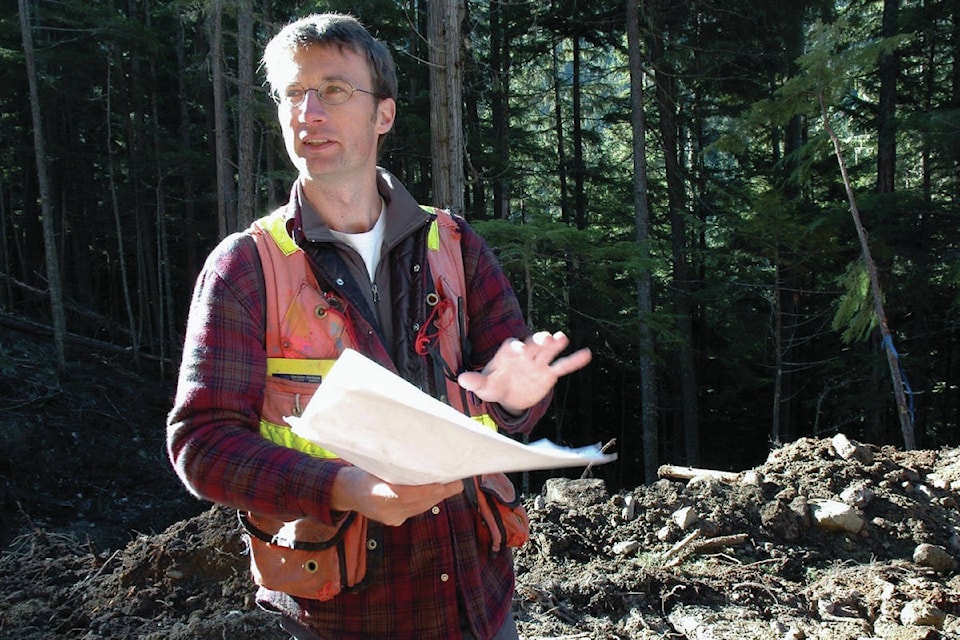The B.C. government has just wrapped up a public consultation that may lead to changes in how residents are consulted and informed about resource extraction decisions.
It is reviewing a practice known as the professional reliance model, which has been in effect since 2004 when the B.C. Liberal government came to power. That’s a system where a resource company hires a professional (a forester, geotechnical engineer, hydrologist, biologist, or soil scientist) to make the decisions about whether a project should go ahead and under what conditions, rather than that decision being made by the government.
For example, a timber company might hire a private professional hydrologist to decide how a planned logging operation might affect drinking water. This process is currently underway in controversial logging plans in Ymir and Glade.
Critics say this amounts to the privatization of the forests because neither the logging company nor the professionals they hire are accountable to the public.
In fact some say this model puts the hired professionals in a potential conflict of interest: would they be tempted to approve of a project in the hope it might lead to further work with the same resource company? Would the logging company simply reject the report if it didn’t provide the answer the company wanted?
Erik Leslie thinks the situation may be a bit more nuanced than that. He’s a professional forester whose situation is unusual because he’s employed by a community co-op, the Harrop Procter Community Forest. That means that for him the logging company and the public are more or less the same thing.
But in conventional situations he agrees there is a tension there — potential divided loyalties — because “as a professional, you have a duty to both the public and to your employer.”
But what if the public and the employer (a logging or mining company) have different interests?
Leslie says that around 2004, there was a shift in who made decisions about forestry cutting plans.
“Under the Forest Practices Code (from the mid-1990s to 2004) “the government was much bigger and every plan had to be approved by a government employee.”
He says that about 15 years ago the regional forestry office closed in Nelson and “no one denies that the size of government in the natural resource industries is significantly smaller now. The scope of professional reliance is much larger now, it is a transition away from the more prescriptive Forest Practice Code with regular government review and decisions.”
Now, he says, with decisions being made by resource companies and consultants they hire, “many people in the watersheds in the Kootenays feel the professionals making the decisions are not answerable to them.”
One of those people is Jason Leus of Ymir, a community involved in intense discussions with a logging company over the safety of Ymir’s water supply in the face of proposed logging.
“Industry hiring their own chosen experts to green light their own projects allows for easy conflict of interest to happen,” he said.
Leslie says its an issue of legislation.
“It used to be that on certain types of terrain that was potentially unstable, the licencee (logging company) had to hire a professional geo-scientist, and the report was provided to the government as well as the licencee, and then the government would decide. That is not required any more. Now it is up to the licencee to decide whether they need to hire this other professional.”
Related:
- Ymir residents decry planned watershed logging (May, 2017)
- RDCK entangled in watershed logging controversies (July, 2017)
- Logging in watersheds: Nelson area logging companies weigh in (November, 2017)
Leslie said forest companies can legally decide whether or not to disclose certain critical details to the public, like road location, cut blocks and their location, and what the harvesting is planned within each block. He said they are not required to disclose this, although some do.
“Kalesnikoff, for example, puts all their plans and blocks on their website.”
Ken Kalesnikoff, who heads the Interior Lumber Manufacturers Association, told the Star that divided loyalties are not an issue for professionals and that the professional reliance model works well.
“The professionals on whom we rely — both within our member companies and outside consultants – continue to uphold the highest standards. As locally-owned and operated companies, we feel a heightened need to ensure our operations are above reproach and we depend on these professionals to guide our work.”
MLA Michelle Mungall, asked what problem the government is trying to solve with this review, said, “We observed over the last 16 years is that there wasn’t a rigour coming from government’s approach to make sure those high standards were being met. And that resulted in the public not having the confidence they deserve to have.”
In a 2016 report, the Auditor General of B.C. wrote that there was not enough government oversight of decisions made by mining companies and the professionals they contracted.
The Forest Practices Board, in a 2013 report, said professionals should not be tasked with defining the public interest. In a 2014 report a BC Ombudsman report said essentially the same thing.
The Ministry of the Environment and Climate change will release a report in the review later this spring.
bill.metcalfe@nelsonstar.com
Like us on Facebook and follow us on Twitter
